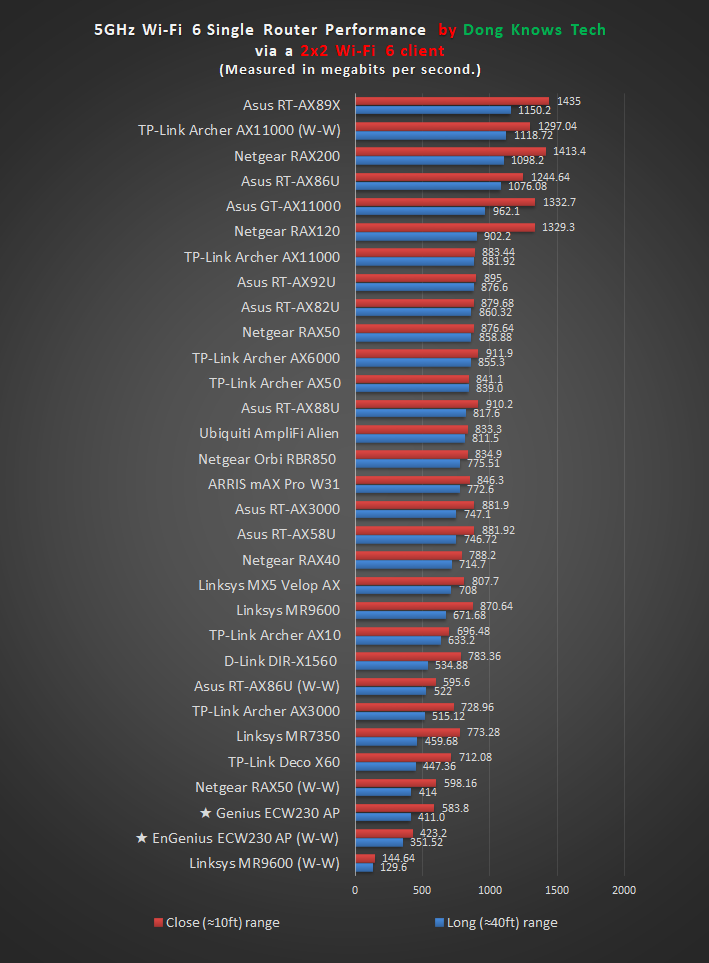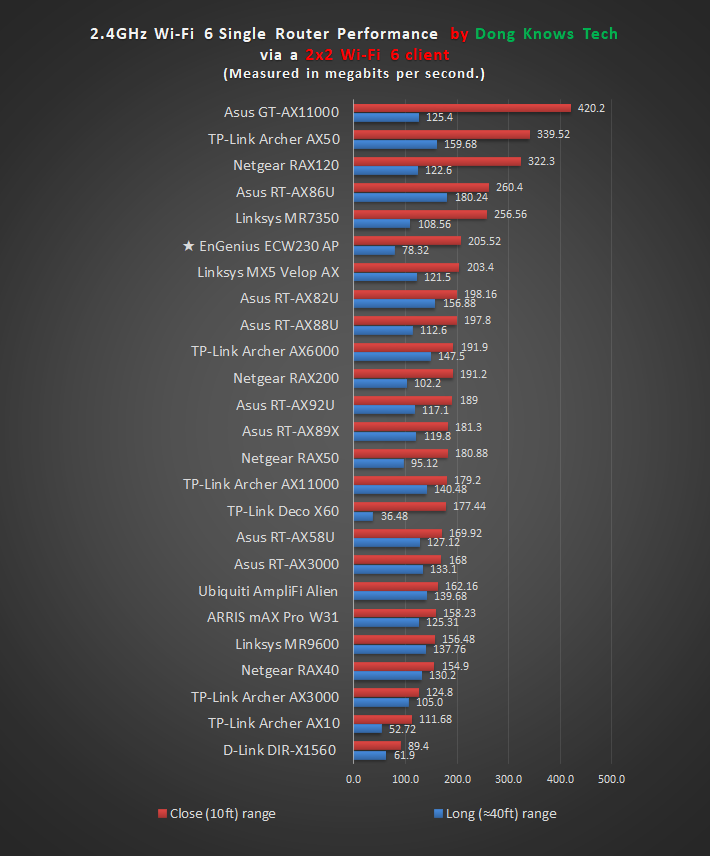The EnGenius ECW230 Cloud Managed Wi-Fi 6 4×4 Indoor Wireless Access Point (WAP) is like a good-looking, relationship-material significant other who happens to be high-maintenance and has a cranky mother.
It’s hard initially, but once you’ve given it enough attention, you’ll be happy with it in the long term. That’s if you can afford its current price of $600 a pop without a power adapter.
That said, whether or not this new Wi-Fi 6 AP is worth the effort depends on your level of commitment and desperation and your ability to handle a somewhat non-traditional product. If that seems like something that resonates with your situation, read on!

EnGenius ECW230: More, yet also less, than a typical Wi-Fi access point
First and foremost, the EnGenius ECW230 is a Wi-Fi access point. And like all others, it requires a wired environment with an existing router. It won’t work just by itself. Again, that’s the case with all access points.
No power adapter or PoE injector included
But you’ll need more with the ECW230. The device doesn’t include a power adapter out of the box—you’ll need to get one for another $15 or so.
Since it’s a Power-over-Ethernet (PoE) device, which is a good thing, alternatively, you can power it via a network cable. Unfortunately, though, it doesn’t come with an injector, either. So, again, you need to get one, or better yet, a PoE+ switch.
In short, unless you already have a PoE-ready network, don’t expect to use this Wi-Fi 6 broadcaster right out of the box. Other business-class access points I’ve worked with, such as the TP-Link EAP245, generally include a power adapter, injector, or both.

Simple and practical design
The EnGenius ECW230 comes in a design that’s easy to look at and work with. It’s a square—9.65-inch (245-mm) wide and 3.35-inch (85-mm) thick. It’s also relatively light, at just .31 lbs. (597 g).
The AP includes amounting accessories: two brackets and a couple of screws. It’s straightforward to mount it on a wall or a ceiling. So the hardware installation is a no-brainer.
Strictly cloud-managed, easy setup
When it comes to getting the AP up and running, EnGenious means business when it calls the ECW230 a Cloud Managed access point. You cannot set up this access point without the Internet.

Indeed, the device has a local web interface that you can access via its IP address. However, you can only view the status, upgrade the firmware, and not much else. There’s no way to set up its Wi-Fi network. In other words, you can’t make it work as a Wi-Fi access point this way.
You’ll first need to download the mobile app and log in with an EnGenious Partner account (or use an existing one from Google or Facebook). And now, apart from using the app, you can also access the AP’s interface via the cloud portal at cloud.engenius.ai, which allows you to access its full potential.
That said, if you’re OK with this vendor-dependent management—and the privacy risk it implies—setting up the ECW230 is a walk in the park. I finished that in less than 20 minutes, including the time to mount the hardware.
It’s worth noting that most business-class APs have this type of cloud-based management. But some of them also allow for local control, where you won’t need to access the device via the vendor.

A bit of a hiccup
I did run into an odd issue with the ECW230. After the setup, the AP appeared offline even though its Wi-Fi network was available and working.
In the end, I had to reset it, which was an odd experience. I did so via the interface—the function was available even though the AP appeared offline. Then I noted a new firmware version was available. After the update, everything consistently worked as expected.
EnGenius ECW230: Detail photos




EnGenius ECW230’s hardware specifications
The EnGenius ECW230 is a 4×4 Wi-Fi 6 access point. However, like most APs, it doesn’t feature the venerable 160 MHz channel width. As a result, its theoretical speed caps at 2400Mbps when working with a 4×4 client. Since we only have 2×2 clients, it now caps at 1200 Mbps.
| Name | EnGenius ECW230 Cloud Managed Wi-Fi 6 4×4 Indoor Wireless Access Point |
| Model | CW230 |
| WiFi Standards | 4×4 Wi-Fi 6 |
| 5 GHz Speeds | 5.0GHz: 2400Mbps |
| 2.4 GH Speeds | 2.4GHz: 1148Mbps |
| Channel Width Support | 20 MHz / 40 MHz / 80 MHz |
| Backward Compatibility | 802.11ac/n/g/a/b |
| Power over Ethernet (PoE) | 802.11at |
| PoE Power Consumption | 19.5W |
| Network Ports | 1x 10/100/1000/2.5GBASE-T PoE (IEEE 802.3at Power over Ethernet) |
| Wireless Security Methods | WPA3, WPA2 Enterprise (AES), WPA2, AES-PSK Hide SSID in Beacons MAC Address Filtering (Up to 32 MACs per SSID) Wireless STA (Client) Connected List SSH Tunnel Client Isolation |
| OFDMA | Uplink and Downlink |
| Target Wake Time Support | Yes |
| Mobile App | EnGenious Cloud To-Go |
| Dimensions (W x D x H) | 8.27 x 8.27 x 1.31 in (210 x 210 x 33.2 mm) |
| Weight | 1.31 lbs. (597 g) |
| LED | Four (4): Power and Cloud connection; LAN speed; 2.4GHz status; 5.0GHz status |
| Processor | Qualcomm Quad-Core ARM Cortex A53s 2.0GHz CPU |
| Warranty | 2-year |
But compared to other dual-band Wi-Fi 6 APs, such as the recently announced Netgear WAX610, the ECW230 still has double the bandwidth, meaning it can handle more concurrent clients without slowing down.
The ECW230 has just one network port (which also works as its power port via PoE). This port is 2.5 Gbps-capable. However, chances are you won’t be able to use it at a higher speed than 1 Gbps. For a couple of reasons:
- Most PoE switches or injectors on the market cap at 1 Gbps. As far as I know, there’s no multi-gig PoE injector or switch yet.
- You can use a multi-gig switch (or a router), but in this case, you will also need a power adapter for the access point. Using a power adapter limits the versatility and placement of the AP and, therefore, is not practical.
That said, the multi-gig serves mainly as a potential rather than something you can use right out of the box. Also, the lack of a second network port means you won’t be able to use a wired device like another AP in a daisy-chance setup.
Lots of advanced settings

You can choose to use the EnGenius ECW230 as its default settings, or you can customize its Wi-Fi, and other features, to your liking. And there are a lot of them.
For example, you can create up to 8 virtual Wi-Fi networks (SSIDs) for both bands. And there are tons of other settings too.
One of my favorites is you can set up a captive portal for an SSID. This feature comes in handy if you want to provide a public hotspot. In this case, you can make the user sign in via Facebook, a voucher, or a particular service, or you can make them agree to standard terms of use.
On top of that, there are also many ways to manage connected clients and monitor their online activities. The network owner has complete control over those who connect to the access point.
And if you use multiple hardware units—including EnGenious’s other Cloud Managed access points, you can turn them into a mesh network. By the way, if you use an EnGenious switch, the cloud portal can manage it too.
Overall, like most business-class access points, there is a lot you can do with the EnGenius ECW230, many of which are irrelevant to a home network.

EnGenius ECW230: Reliable performance
I tested the EnGenius ECW230 using a $350 EnGenius Cloud 8-port Gigabit POE switch (model ECS1112FP) for more than ten days and had no issue with it other than the short hiccup mentioned above. The AP delivers excellent coverage and reliability.
The single unit I used could easily cover some 2000 ft² (186m²) of a residential environment (multiple rooms with plaster walls). And I experienced no disconnection.
Decent throughput speeds
As for throughput speeds, the AP did relatively well in my testing, considering there’s no multi-gig PoE switch and the lack of support for the 160 MHz channel width.

In my standard wired-to-wireless tests, my 2×2 test client connected to it consistently at 1.2Gbps and registered a sustained speed of more than 580Mbps at close range. When I move it farther out, it now averaged some 410 Mbps.
And in extra tests where I copied data from one 2×2 Wi-Fi 6 client to another, the AP registered 423Mbps and 351Mbps for close and long ranges, respectively.

The AP did much better comparatively on the 2.4 GHz band. My 2×2 Wi-Fi 6 clients averaged 205Mbps and 78Mbps at the close and long ranges, respectively.
The AP did similarly well with Wi-Fi 5 clients. At a close range, my 4×4 test machine had a sustained speed of 500 Mbps. Farther out, my 3×3 client averaged faster than 450 Mbps.

So, compared with home routers, the EnGenious ECW230 didn’t have enough to wow anyone. But it’s important to note that it’s optimized for reliability and not necessarily speeds as a business device.
EnGenius ECW230's Rating

Pros
Reliable performance, excellent coverage
Easy-to-use
Nice design, ready to mount
2.5Gbps PoE network port
Convenient, subscription-free cloud-based management
Cons
Expensive yet doesn't include a power adapter or PoE injector
Requires Internet and a login account for setup and ongoing management
Comparatively slow throughput speeds
No 160 MHz channel width support
Conclusion
With many features and an easy-to-use and versatile cloud-based portal, the EnGenius ECW230 Cloud Managed Wi-Fi 6 4×4 Indoor Wireless Access Point has a lot going for itself. Unfortunately, it’s just too expensive for now.
Indeed, Wi-Fi 5 alternatives, like the TP-Link Omada series, can deliver a similar experience at a much lower cost. Keep this AP in mind and snatch it when you find a good deal. My take is that its price will decrease as Wi-Fi 6 becomes increasingly popular.
But if you decide to get it now, chances are it will work out after the above-mentioned little surprises.


Looks like EnGenius has the same setup as Unifi in many cases.
Have you also used Aruba Instant on?
Yes, it’s similar to that of other vendors, too, like Netgear or TP-Link. I haven’t tried Aruba yet.
Would love to see you review Aruba Instant On AP22 .11ax 2×2 WiFi Access Point.
Noted, Kam.